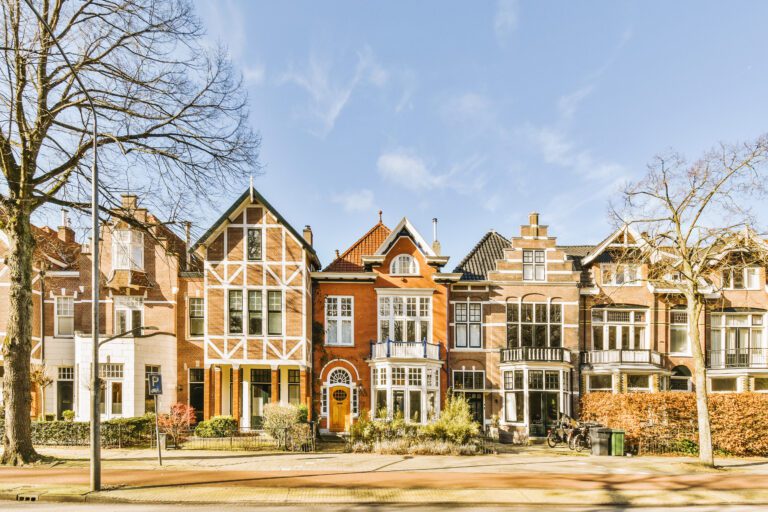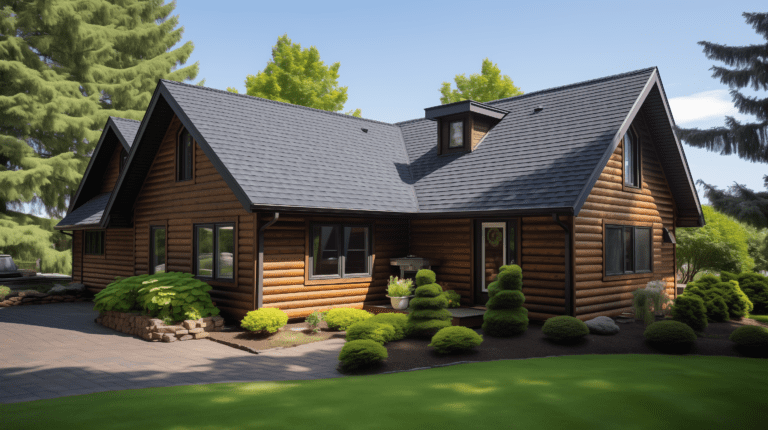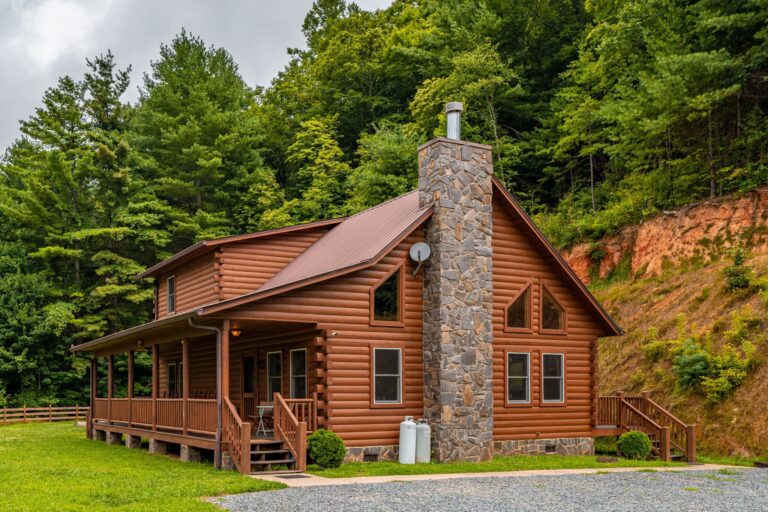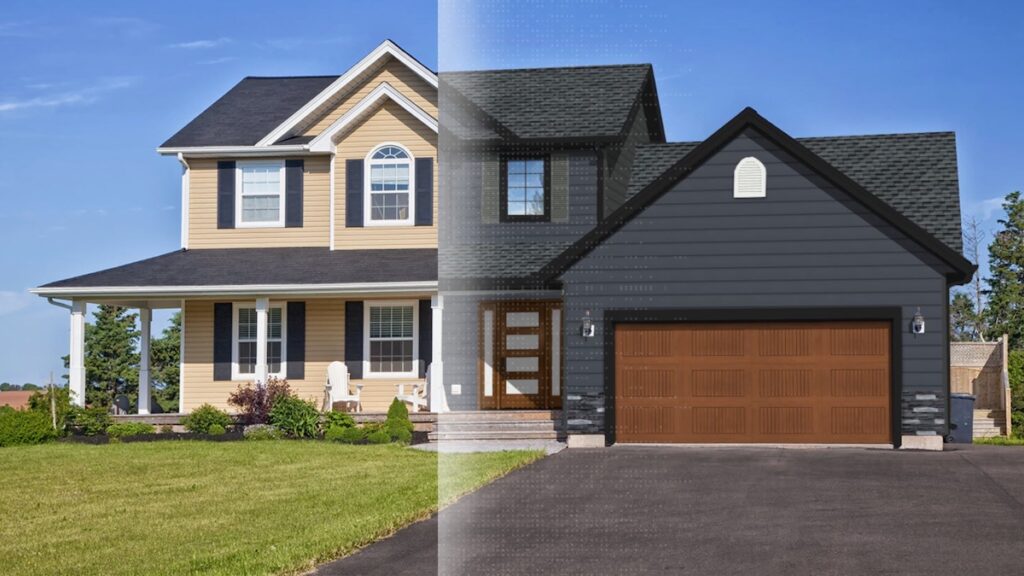Choosing the right wood siding can enhance your home’s curb appeal, durability, and overall aesthetic. This guide breaks down the most popular styles and materials to help you make an informed decision.
- Clapboard, Board & Batten, and Shingle Siding – Classic and rustic styles that define a home’s exterior.
- Cedar, Pine & Redwood – Natural wood options with varying levels of durability and maintenance needs.
- Engineered, Thermally Modified & Cypress Wood – Specialty materials offering longevity and resistance to elements.
- Alternative Options – Fiber cement, vinyl, and stucco for those seeking lower maintenance solutions.
Looking to visualize different siding options on your home? Try Renoworks’ AI-powered siding design tool and bring your exterior vision to life!
Introduction
Have you ever walked past a house and felt drawn to its warmth, charm, or rustic elegance? That captivating allure often comes from the type of wood siding adorning its exterior. Wood siding isn’t just about aesthetics; it’s an investment in your home’s character and value.
Imagine running your fingers along smooth cedar planks or hearing the gentle creak of weathered pine underfoot. Each type offers unique benefits—from durability to insulation—that might surprise you. Whether you’re renovating an old farmhouse or building a modern retreat, understanding these options can transform not only how your home looks but also how it feels.
So why settle for ordinary when extraordinary is within reach? Let’s dive into the world of exterior wood siding, from popular styles to different material considerations, to find and uncover which one could be perfect for bringing out the best in your home’s personality,
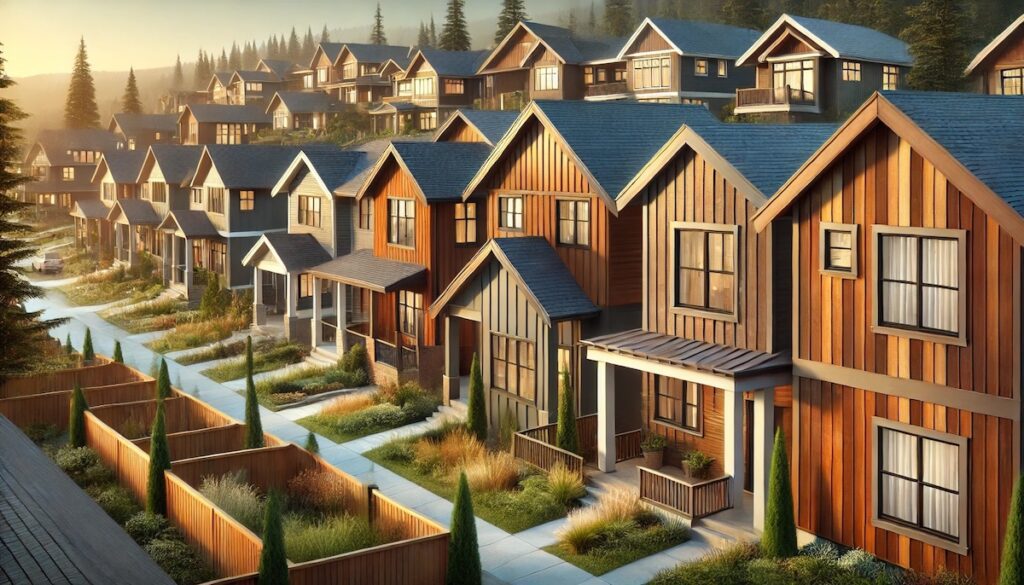
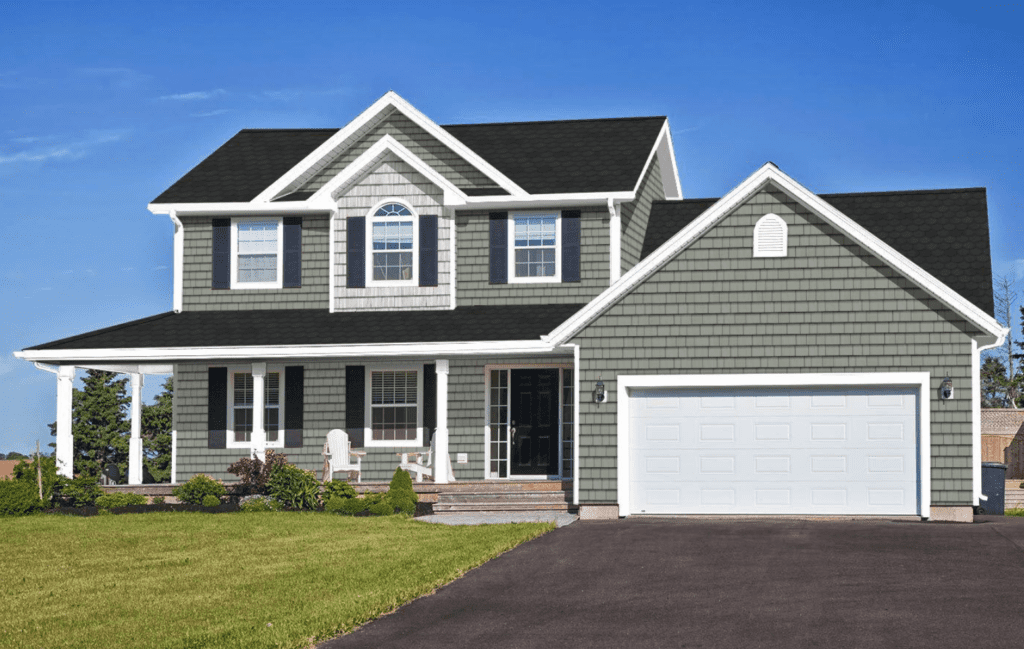
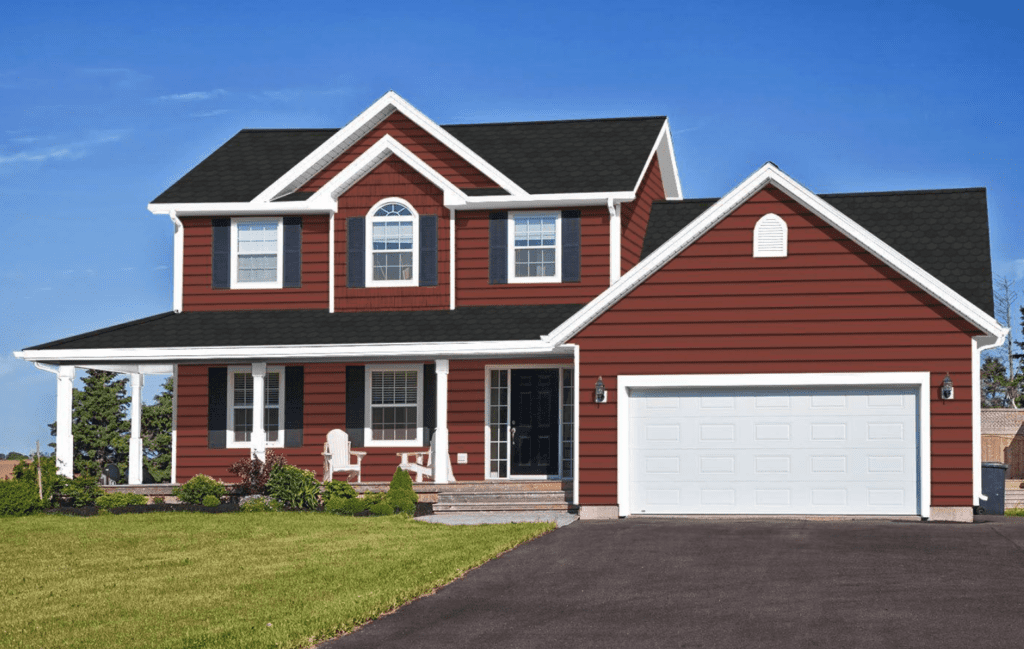
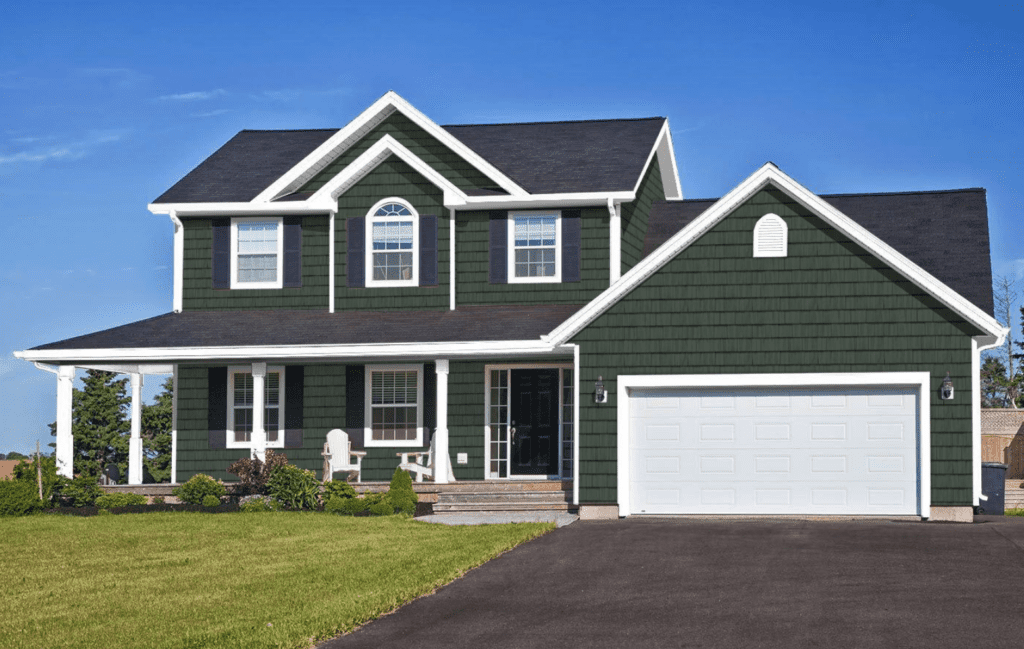
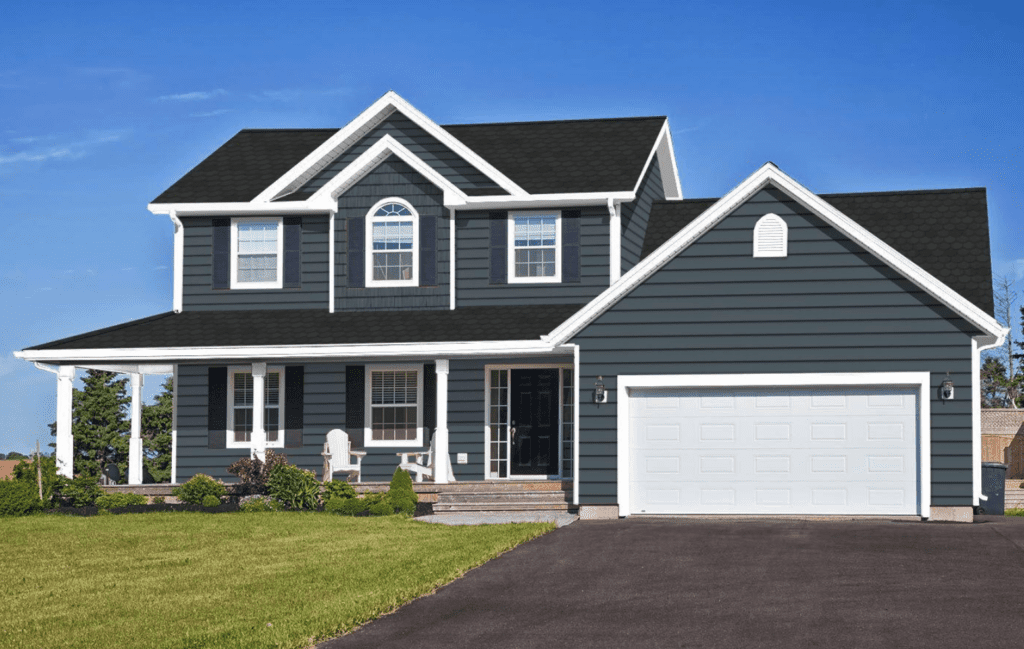
SIDING VISUALIZER TOOL
Design A Home In 5 Minutes
Help your homeowners visualize new siding and colors on their own home with Renoworks’ AI technology in seconds.
- Easy-to-use interface designed for contractors and professionals working with homeowners.
Popular Styles of Wood Siding
Wood siding offers a variety of styles, each bringing its own charm and functionality to your home. Let’s dive into some popular types that you might find intriguing:
Clapboard Wood Siding
Clapboard wood siding is one of the most traditional choices for homes. It features long, horizontal planks overlapping each other in an elegant yet functional manner. This style originated from early American colonial architecture but has stood the test of time due to its classic look and practicality.
The appeal lies in how it creates clean lines on your exterior siding walls while providing excellent weather protection. The natural grain patterns add texture and depth, making every piece unique—no two boards are exactly alike! Cedar often gets used here because it’s durable against rot and pests.
Board and Batten Wood Siding
Board and batten siding gives off a rustic vibe that’s both charmingly old-fashioned yet surprisingly contemporary when applied right. Imagine vertical wooden boards running along your home’s façade with narrower strips (battens) covering seams between them—that’s board-and-batten!
This design can make buildings appear taller by drawing eyes upward; plus, those battens create delightful shadows adding visual interest throughout daylight hours—especially stunning during golden hour if you’ve ever noticed! Pine or fir typically serve well for this type since they’re easy enough materials even DIY enthusiasts could handle without too much hassle involved overall process-wise speaking anyway.
Shingle Wood Siding
Shingle wood siding brings coastal charm right onto your property! These are small pieces typically cut from cedar which naturally resists decay (a major plus). They’re layered so their edges overlap creating an eye-catching pattern whether left natural or painted white reminiscently beachy cottages dotting New England shores.
One thing to appreciate about shingle siding —they age beautifully, taking on silvery patina as years go by adding even more charisma while requiring minimal upkeep compared to other styles.
Wood Siding Materials
Wood siding offers an unparalleled blend of natural beauty, durability, and versatility. Different types cater to various aesthetic and functional needs, and have different characteristics.
Cedar Siding
Cedar wood siding is a favorite for its natural beauty and durability. This type of wood resists decay and insects better than many other options. One thing people love about cedar is how gracefully it ages; over time, it takes on a lovely silvery patina that adds character to any home. It’s perfect if you’re looking for something that’s both low-maintenance and aesthetically pleasing.
Pine Siding
Pine wood siding offers versatility at an affordable price point but does require more maintenance compared to cedar. Pine‘s softwood nature means it’s easier to work with during installation, making those DIY projects less daunting! However, pine can be prone to warping or cracking if not properly maintained—regular sealing or painting helps mitigate this issue.
Redwood Siding
Redwood is simply stunning with its deep red hue that instantly elevates any home’s exterior. Its resilience to rot and pests makes it a high-quality option if you’re looking for longevity without constant upkeep. One thing people love about this type of wood is how little maintenance it requires compared to other materials—just occasional washing keeps it in top shape. Given these qualities along with its aesthetic appeal and low-maintenance nature make redwood a smart investment despite being on the pricier side.
Additional Wood Siding Options
Wood siding has many other options outside of the top 3 mentioned above, and while we can’t cover every single siding option available, the below options cover the vast majority of the types of wood siding materials people typically consider:
Engineered Wood
Engineered wood combines natural beauty with modern technology’s durability and cost-effectiveness; it’s essentially made from various layers of real lumber bonded together under pressure—a great alternative if you want something robust yet aesthetically pleasing like traditional hardwoods but less expensive than solid timber sidings available today!
It often features realistic textures mimicking authentic grains found on higher-end species such as oak & mahogany (to name just two examples). Plus maintenance requirements tend toward minimal efforts since manufacturers usually apply protective coatings during production stages already designed specifically against common issues associated w/natural materials like pests.
Douglas Fir Wood
Douglas fir isn’t just any ordinary softwood, think rustic elegance meets practicality here! Known for its strength-to-weight ratio, Douglas fir offers remarkable stability which makes it less likely to warp when exposed to moisture changes compared with some others out there—especially pine! The grain pattern on Douglas fir also adds an appealing texture that stands out beautifully once stained or painted.
Cypress Wood
Cypress offers durability due to its natural oils which help resist rot and bugs—perfect if you live in a humid area! Not only does cypress offer functional advantages but visually speaking—it ages gracefully turning into silvery-gray patina overtime adding rustic elegance effortlessly enhancing curb appeal significantly. Plus, when stained or painted properly, this wood can be quite stunning visually.
Thermally Modified Wood
Thermally modified wood is fascinating. This process involves heating the wood at high temperatures, which changes its structure. It makes the material more durable and resistant to decay without using chemicals. Thermally modified wood has a beautiful dark color after treatment, giving homes an elegant look while being eco-friendly.
This type of exterior wood siding can also improve dimensional stability by reducing moisture content in the wood fibers through heat application—ideal for regions with fluctuating weather conditions where regular woods might warp or swell over time.
Considerations for Choosing Wood Siding
Choosing the right wood siding involves balancing several factors. Each type has unique attributes, making some better suited to specific conditions and preferences.
Durability and Maintenance
When considering wood siding, durability stands out as a crucial factor. Cedar and Redwood shine here due to their natural resistance to decay and insects. However, all woods need regular maintenance like sealing or staining every few years; otherwise, they might weather poorly over time. Meanwhile, Pine is quite affordable but tends not to last as long compared with other types unless treated properly against pests and moisture damage.
Engineered Wood provides another interesting option since it’s designed for enhanced durability while mimicking real wood‘s appearance closely. This can be especially appealing if you’re aiming for longevity without frequent upkeep demands typical of traditional real wood options.
Aesthetic Appeal
The look of your home matters just as much when choosing exterior siding materials! Clapboard offers classic charm reminiscent of historical homes found throughout New England towns — it’s perfect if you want timeless elegance combined seamlessly into modern settings too!
Shingle sidings offer more texture variation which adds visual interest particularly suitable around coastal areas (like those charming beach houses). On the other hand, Board and Batten creates striking vertical lines adding height illusion beneficially transforming single-story structures in an aesthetically pleasing way. If you’re ever driving through the Midwest plains region, you’ll notice this effect prominently in the rustic farmhouses scattered across the region.
Alternatives to Wood Siding
While wood siding offers charm and warmth, there are excellent alternative types of siding for those seeking different benefits like lower maintenance or cost. Let’s dive into a few of the popular options.
Fiber Cement Siding
Fiber cement siding’s a fantastic alternative siding option if you’re looking for durability without the high upkeep of wood. Made from a mix of cement, sand, and cellulose fibers, fiber cement mimics the look of real wood but resists rot and insects much better. This material can withstand extreme weather conditions too—think heavy rains or intense sunlight—which is perfect if you live in an area with fluctuating climates.
Fiber cement often comes pre-painted or primed so it’s easy to match your home’s aesthetic right out of the box. It’s also fire-resistant—a huge plus when safety is on your mind—and requires far less frequent painting than traditional wooden sidings do.
If you’re considering this option due to its low maintenance needs yet still want that classic look only natural materials provide, then fiber cement could be just what you need.
Vinyl Siding
Vinyl siding might not be your first thought versus real wood however modern advancements have changed all that! Nowadays vinyl closely resembles painted clapboard even upon close inspection making it another viable siding option especially given how affordable installation costs are. Vinyl siding is comparatively cheaper upfront along with minimal future repairs required beyond occasional cleaning sessions annually.
Stucco Siding
Stucco siding has this old-world charm that’s hard to resist. Made from a mix of cement, sand, and lime applied in layers over a wire mesh frame, this type of siding creates this solid yet textured look on your home’s exterior. It’s great for those looking for something unique but also robust since stucco resists fire and pests quite well. It works best in dry climates because moisture can sometimes cause issues like cracking if not properly maintained. However, newer synthetic versions have improved water resistance making them more versatile across different regions.
Conclusion
Choosing the right wood siding for your home can significantly impact its aesthetic and durability. From classic options like Cedar, Pine, and Redwood to specialized choices such as Thermally Modified Wood and Engineered Wood there’s something for every homeowner’s taste. Don’t forget to consider maintenance requirements when making your decision.
Exploring alternative types of siding like fiber cement, stucco or vinyl siding might also offer practical benefits depending on your needs. Each material brings unique advantages whether it’s weather resistance energy efficiency or affordability. Take the time to evaluate all factors before settling on the perfect siding for your home ensuring both beauty and longevity in one package.
Frequently Asked Questions
What types of wood siding are popular for homes?
Popular options include Cedar, Pine, and Redwood. These woods offer warmth, charm, and durability.
What are some specific styles of wood siding available?
Common styles include Clapboard, Board and Batten, and Shingle siding. Each style provides unique aesthetic appeal and functionality.
Are there any specialty wood sidings I should consider?
Yes! Specialty options like Thermally Modified Wood, Engineered Wood, and Cedar Siding provide enhanced durability along with aesthetic benefits.
Why is Redwood a good choice for wood siding?
Redwood is known for its rich color and resistance to decay. It offers both beauty and longevity in home projects.
How does Cypress compare as a material for wood siding?
Cypress is valued for its natural durability against elements while providing an appealing visual look that enhances the exterior of homes.
Is Pine or Fir better suited for budget-friendly home projects?
Both Pine (especially White Pine) and Fir are affordable choices offering versatility; they can be stained or painted to match various design preferences.
What factors should I consider when choosing wood siding?
Consider aspects such as durability against decay/insects, maintenance requirements (regular upkeep needed), cost-effectiveness versus aesthetics offered by different types/styles of wooden materials used in construction work at your place!
How do alternatives like Fiber Cement Siding compare to traditional wood options?
Fiber Cement Siding stands out due its superior strength & low-maintenance properties making them viable substitute compared conventional ones – no frequent repainting required unlike those other kinds made from actual timber trees grown naturally over years…




SIDING VISUALIZER TOOL
Design A Home In 5 Minutes
Help your homeowners visualize new siding and colors on their own home with Renoworks’ AI technology in seconds.
- Easy-to-use interface designed for contractors and professionals working with homeowners.
Related Articles
Continue exploring this topic with these related articles, or read one of our case studies to see how visualization has helped remodelers save time and increase their profits.


